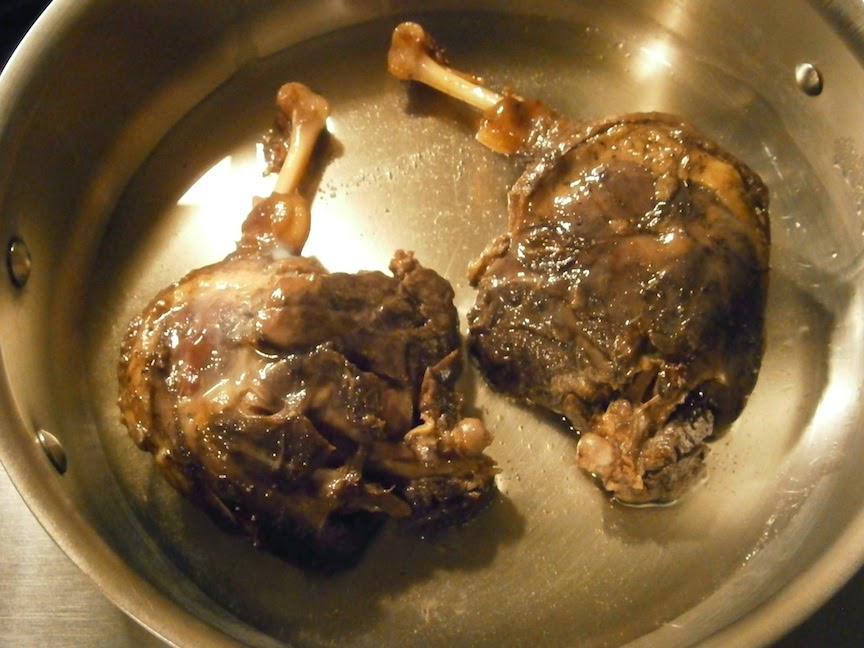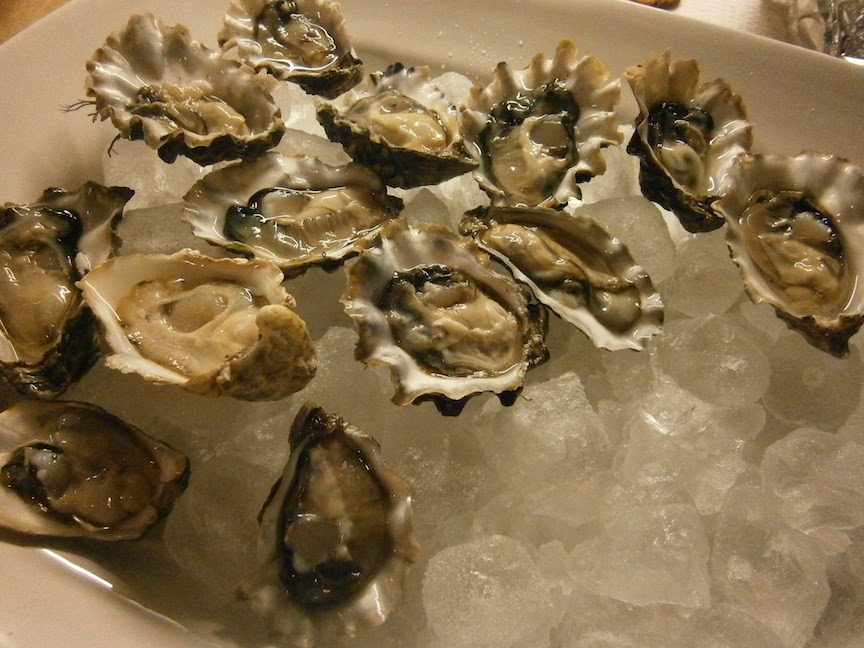 |
| Huge, I mean HUGE, serving of lusciousness |
Cassoulet in three hours. Right... But, I since made duck leg confit a few weeks ago, and it's just hanging around, let's do this. I mean, how convenient is that to just happen to have a couple of homemade duck legs, confit? Score!
As Published, serves 4-6 |
As Made, serves, well, more than two, even though we halved the recipe, really… |
One day ahead: |
All on same day: |
1. Cover 1½ pounds of dry white beans with cold water and
soak for one hour. (Cannellini work well. Paris Eastside carries traditional French
Tarbais beans.) Drain and reserve.
|
One 15 ounce can of Great Northern Beans, rinsed. We use
Simple Truth Organic – unlike other brands of canned beans I’ve opened over
the years, this brand provides firm beans that will hold up in further
cooking, not mushy ones that disintegrate with a few stirs of the pot.
|
2. Make the broth. You will need 3 to 5 ounces of cured
bacon; 2 smashed garlic cloves; 1 onion quartered, and several large pieces
of pork skin cut into strips. (Find pork skin at Uwajimaya or ask your
butcher. You will need enough to cover the bottom of the cast iron cocotte or
Dutch oven you will use for the cassoulet. This prevents the beans from
scorching.) Place all the ingredients in a large pot. Add salt, pepper and 12
cups of water. Simmer very low, partially covered for two hours. Refrigerate
until needed.
|
2 ounces bacon, homemade, of course
1 smashed clove garlic
2 quarters of onion with skin
2 bay leaves
small stalk celery with leaves, halved
small carrot, peeled, halved
Frankly, pork skin is not needed. Yes, in the broth, it
will release gelatin and make for a luxurious sauce. Lining the bottom of the
pot? Not needed when you bake. Stove top? Probably, but not needed in the
oven.
|
To make the cassoulet: |
|
3 tablespoons tomato paste
|
2 tablespoons
|
4 pieces duck confit (scrape off most of the fat and
reserve)
|
2 confit duck legs, homemade, of course
|
3 bratwurst or other garlicky sausage
|
2 fresh Kielbasa links, from Skagit River Ranch
|
2 pounds pork shoulder or pork butt (boneless country-style
pork ribs sold in supermarkets are conveniently cut)
|
1 pound pork shoulder cut into strips
|
5 garlic cloves
|
5 garlic cloves, plus about ½ cup diced carrot and ½ cup
diced onion.
|
Kosher salt, white or black pepper, grated nutmeg to taste
|
OK, pretty much, no problem here...
|
1. Strain the stock into a large pot, reserving the pork
skin. Add tomato paste and pre-soaked beans. Cook 10 to 30 minutes, depending
on the kind of beans. They should remain whole and slightly firm, as they
will continue to cook in the oven.
|
Warmed the canned beans in the stock with the tomato
paste.
|
2. While the beans cook, place the confit in a skillet and
sear on all sides. Next, sear the sausages in the duck fat, then the pork,
then the garlic cloves. Spoon off and reserve any excess fat in a small bowl
as you go, or add more if needed. Use a spatula and a wooden spoon to turn
and lift the meats, instead of tongs, which can break the skin.
|
Seared all the meats in duck fat and didn’t worry
about extra duck fat. In fact, I poured extra in for the browning step.
Really.
Also, sautéed the extra onion and carrot when I sautéed the
garlic (see above). More veg is good. And unlike the French, I can eat sautéed veg in a
sauce. (Carefully drained off all the extra Duck fat before adding the veg
back to the bean/stock mix.)
|
3. Preheat the oven to 375 degrees. Cover the bottom of a
cast iron cocotte or Dutch oven with the pork skins placed fat side down.
Using a slotted spoon, transfer about one-third of the beans to the pot to
cover the skins. Sprinkle with salt, pepper and nutmeg. Arrange the pork on
top of the beans. Place the duck on top of the pork. Scatter the garlic.
Cover the meats with the remaining beans. Add enough stock to just cover the
beans. Place the sausages on top, pushing them gently to slightly submerge.
Add more salt, pepper and nutmeg. Bake uncovered for 1½ hours. As it cooks, a
thin crust will form. Press gently with a wooden spoon occasionally to break
the crust. Add stock if the cassoulet seems too dry.
|
Arranged the meats in the pot, poured the beans and stock
with veg over the meats, and baked.
Just before we decided “it was done,” Dorothy added
buttered bread crumbs on top, and let them get golden. Yes, Panko.
|
4. To serve, portion the beans and meats on plates.
|
Pretty much the same - it is a large portion if you give each bowl some of each meat, including a whole leg. And yes, you do have to serve a whole leg. Really.
|
We served the cassoulet over sautéed Collard greens. They were hit with a bit of lemon juice just before the cassoulet was spooned over them.
Nice easy dinner.
 |
| Beans and tomato paste warming in the stock |
 |
| Homemade duck legs confit searing off in the sauté pan |
 |
| Crusty crumbs on top, cassoulet ready to serve |








